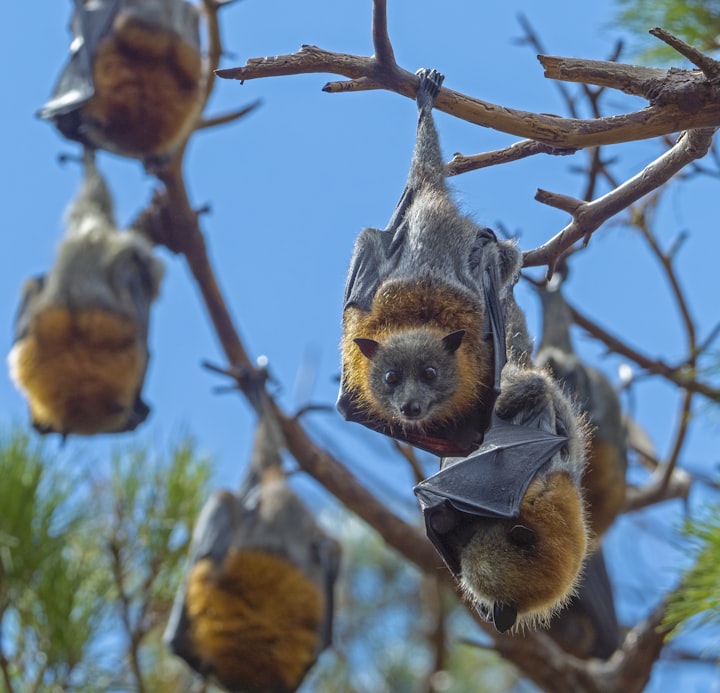How Bats Harbor Deadly Diseases Without Being Fatally Affected
Bats

In the mystical realm of the animal kingdom, one creature stands out with its enigmatic qualities - the bat. Picture this: a fluff of wings, soaring through the night sky, akin to a whimsical dancer traversing the cosmos. At first glance, they're the quintessential oddballs of the mammalian world, but as strange as they may seem, there's an undeniable allure to these airborne marvels.
However, bats don't exactly get the best press. Often, when they swoop into the limelight, it's accompanied by headlines of catastrophic diseases like Ebola, COVID-19, and the recent Nipah virus outbreaks. The blame invariably falls on these creatures. But here's the twist - while bats are linked to these lethal diseases, we don't stumble upon caverns teeming with bat casualties from these viruses. It appears bats don't just harbor these deadly diseases; they thrive in their presence. How? Well, let's take a flight into their fascinating world.
Imagine this: to take wing, a bat revs up its energy output to levels unimaginable. While a human sprinting at full tilt might double their metabolic rate, a bat, in its aerial escapades, can elevate it up to 15 times! Their hearts pound at a frenetic thousand beats per minute, dwarfing their resting rate four to fivefold. But that's not all. As they soar, their body temperature skyrockets to a scorching 44 degrees Celsius—hovering just shy of the lethal limit for mammals at 45 degrees Celsius. This high-flying lifestyle pushes their physiological boundaries to the brink of thermal endurance.
You're probably wondering, what's the connection between bat physiology and these viruses? Strap in, because here's where it gets intriguing. Flight, as it turns out, mimics a significant stressor akin to aging for bats. However, evolution has equipped these remarkable creatures with unique molecular pathways to combat this stress-induced damage. In essence, bat physiology seems to defy the aging process, allowing them to thrive despite expending colossal amounts of energy constantly.
Here's the kicker - typically, there's a trade-off between metabolic output and lifespan in mammals. Take rodents, for instance; their brevity of life is proportional to their metabolic vigor. Bats, on the other hand, share a similar size and surpass rodents in metabolic expenditure, yet they boast remarkable longevity. In fact, some species can live up to a staggering 40 years in the wild, making bats, pound for pound, the most enduring mammals on Earth.
Now, how does all this relate to viruses? Let's delve into the immune response. When viruses invade humans, our immune system triggers a dual-switch mechanism. The first switch alerts the body of the intruder, while the second kickstarts an immune response to combat it. But here's the hitch - this robust immune response often leads to severe symptoms and inflammation, which can be detrimental to the body.
Bats, however, operate on a different level. Their immune system's response to viral invasion diverges from ours. Some species keep their alarm switched on perpetually, while others are in a state of hyperdrive, preemptively releasing molecules to thwart viral replication before it even takes root. Moreover, their inflammation switch appears to have a permanent dimmer, mitigating the severe side effects seen in other mammals. This unique immune strategy allows bats to reduce viral loads to incredibly low levels and tolerate residual viruses, making them ideal hosts but potentially hazardous to humans.
But hold on before casting bats as villains! There's a treasure trove of knowledge to glean from these captivating creatures. Researchers are unlocking insights from bats to advance human medicine, mirroring their unique immune mechanisms in treating diseases. Mimicking their dual-switch system, treatments for severe COVID cases utilize antiviral drugs to reduce viral loads and anti-inflammatory steroids to temper the immune response.
However, bats aren't impervious. Elevated stress due to climate change, habitat loss, and human intervention can exacerbate viral shedding and transmission among bat populations, posing risks to human health. Yet, a healthy bat becomes less of a zoonotic threat, offering a valuable resource for medical research and a compelling argument for bat conservation to safeguard human well-being.
As we draw the curtain on this bat-tastic journey, remember, this is just the tip of the wing. The plethora of bat species and the diseases they carry, alongside their own challenges like white nose fungus, remain unexplored. The enigmatic world of bats invites us to delve deeper, to unravel the mysteries they hold.
So, let this be an invitation to explore, a beckoning to dive into the vast expanse of knowledge these creatures offer. After all, from understanding bats, we might just unlock the secrets to better disease treatment and prevention in our own species.





Comments (1)
This is a great story. I enjoyed this story. If you want to read my story then visit this link https://vocal.media/confessions/mee-and-adon-s-odyssey-of-love